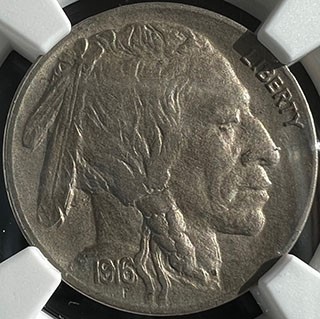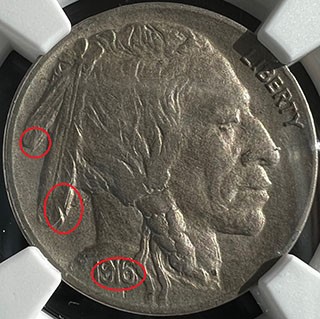NGC Certifies Key 1916 Doubled Die Obverse Buffalo Nickel Discovery Coin
Posted on 2/14/2023
NGC has certified the first-ever reported 1916 Doubled Die Obverse Buffalo Nickel. The coin has remained in the possession of the family of Pomona, California, collector Herbert S. Perlin for over 60 years. In 1962, Perlin sent photographs of his discovery to Numismatic Scrapbook Magazine. The July 1962 article describing the coin and its prominent date doubling was the first published report of the die variety. With roughly 300 examples known in all grades, the 1916 Double Die Obverse Buffalo Nickel is the undisputed key of the Buffalo Nickel series.
A doubled die is created during the die-making process. The hub, which has a positive impression of the coin’s design, is pressed into a die blank. Doubling occurs when the hub shifts or rotates between presses, causing the design to be duplicated. Each coin struck from this die exhibits identical doubling.
In the instance of the 1916 Doubled Die Obverse Buffalo Nickel, the shift is most visible on the date, but also clear on the feathers and hair ribbon. These features are evident even on circulated examples. Despite the dramatic nature of the doubling, it took 46 years for the variety to be discovered, an indication of its extreme scarcity.
 |
 |
| Close-up view of the 1916 Doubled Die Obverse Buffalo Nickel Discovery Coin, with some of the doubling highlighted at right Click images to enlarge. |
|
Rising out of obscurity
Likely due to its rarity, the 1916 Doubled Die Obverse Nickel remained obscure after the first images were published. A follow-up article in the Scrapbook in January 1965 reported that specialists were able to account for only six examples, including Perlin’s.
Starting in the mid-1970s, knowledgeable dealers began posting bid prices for the variety. Accordingly, when the first ever Coin Dealer Newsletter Monthly Supplement was published in August 1976, it included a listing for a rather mysterious “1916/16-P” Nickel. The value of $800 for an uncirculated example was the second highest listed for any coin in the series, but it was still only a fifth of the value of the better known 1918/7-D overdate nickel. Several dealers contacted the publisher asking for more information.
Responding in the following month, September 1976, Monthly Supplement ran a front cover story illustrating the doubled die with a description: “As the picture shows, this no a mere ‘recut date’ — but a sharply doubled date much like the 1955/55 Lincoln Cent. ... However, since the 1916/16-P Nickel is not listed in the Redbook, relatively few collectors know of its existence.” The only trade of an uncirculated example they were able to locate was a sale at $2,000, well less than the 1918/17-D overdate. Of this price disparity, they commented: “Serious collectors of Buffalo nickels, however, will have a considerably more difficult time locating the still lower priced double die!”
Continued appreciation
The “Redbook” referred to above is A Guide Book of United States Coins, often referred to as the “bible of US coins.” In the 1978 edition, a long 16 years after Perlin’s discovery, at last they included the 1916 Doubled Die, but without a price. In 1979, the Red Book seemingly slighted the 1916 Doubled Die Obverse with a $600 value in uncirculated (MS 60) condition compared to $9,500 for the overdate. By the mid-1980s, its desirability was recognized and its value exceeded the overdate. It has continued to appreciate in the years since. In MS 60, the current NGC Price Guide value is $60,000. The record price for an NGC-certified example is for a coin graded MS 64 that sold at auction in April 2008 for $276,000.
“This coin is an important artifact. It reminds us of the details of this coin’s discovery,” said Scott Schechter, NGC Chief Numismatist and Grading Finalizer. “It illustrates a truism in numismatics that if something is legitimately scarce and visually compelling, the marketplace will ultimately recognize its worth. We’re very honored to certify this important item and recognize Mr. Perlin’s contribution to Buffalo Nickel collectors.”
Herbert S. Perlin’s coin is a wonderful example with only slight evidence of circulation on the high points of the design. It has been graded NGC AU 58, and only 13 with higher grades appear in the NGC Census. More meaningful, it was this example that made collectors aware of the variety and served as the only published image for its first 14 years as a recognized rarity.
Related Link:
NGC Coin Explorer: 1916 Doubled Died Obverse Buffalo Nickel
Stay Informed
Want news like this delivered to your inbox once a month? Subscribe to the free NGC eNewsletter today!

